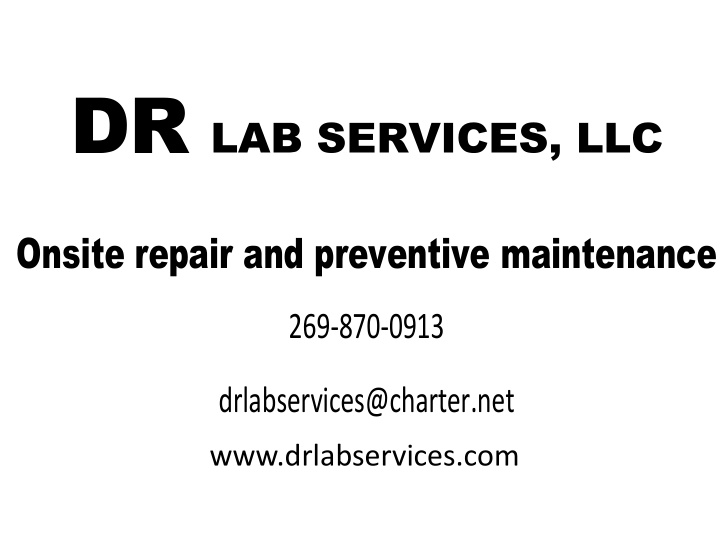



DR LAB SERVICES, LLC Onsite repair and preventive maintenance 269-870-0913 drlabservices@charter.net www.drlabservices.com
Typical instruments serviced Balances Ovens Incubators Sterilizers PH meters Furnaces Refrigerators Centrifuges Fume Hoods Water Baths DO Meters Spectrophotometers Microscopes COD Reactors Digesters Refrigerated Auto samplers
Laboratory Preventive Maintenance Choosing to incorporate a preventive maintenance program: o Improves productivity o Increases equipment up time and utilization o Extends equipment lifetime o Maintains peak performance o Lowers cost of ownership
Preventive Maintenance options o Do nothing, - and hope to coast by without being caught. o Set up a preventive maintenance program, - and run it yourself. o Have an outside company come in and perform an annual or biannual preventive maintenance.
THE ADVANTGES TO HAVING AN OUTSIDE PERSON PERFORM THE PREVENTIVE MAINTENANCE The person in the lab can ask that embarrassing question such as: o How does this new PH meter work? o My standard curve has been flat for month. Can you help me? It is just good laboratory practice. You know your instrument is working correctly and is calibrated. You don’t need to wonder is it the instrument or something else causing the problem. You should get a preventive maintenance check list filled out and a calibration sticker for each instrument. The DEQ loves to see calibration stickers on the instruments.
Use and Care of pH Meter Always use fresh buffers for calibration. Choose buffers that are no more than 3 pH units apart and bracket the expected sample PH. Check electrode slope daily by performing a two-buffer calibration. Slope should be 92-102%. Between measurements, rinse electrodes with distilled water. Stir all buffers and samples during measurement. Place a piece of insulating material (Styrofoam, cardboard) between magnetic stirrer and beaker to prevent error from transfer of heat to sample.
Use and Care of pH Meter Avoid rubbing or wiping electrode bulb, to reduce chance of error due to polarization. Blotting is ideal. Store pH electrode in electrode storage solution when not in use. Never store in deionized water. Always remove covering from electrode fill hole prior to measurement. Try to always soak glass electrodes in electrode storage solution overnight prior to first use.
Use and Care of pH Meter Be careful not to use incorrect fill solution for electrode or application. Do not allow salt crystals to form inside pH electrodes. Frequently inspect electrodes for damage and clogging of external junction. Use appropriate cleaning procedure if electrode becomes sluggish or drifts excessively.
The Proper use of a Balance Accuracy Counts
Setting up Your Balance • Set balance on a heavy stable table. • Table should be level, and free of vibration. • Level the balance. • Place balance away from drafts, and windows. • Place balance in a low traffic area. • Limit the users to only lab personnel.
Rules for Analytical Balances • Perform a calibration or check the accuracy on a regular basis. (Once per week minimum) • Brush spills away from hole. • Do not use compressed air. • Close the balance door while weighing an object. • Only glass, ceramic, metal, or plastic containers should be placed in direct contact with the pan. • Do not handle objects with bare hands. • Never weigh chemicals directly in contact with the pan.
• To be weighed accurately, all objects must be at room temperature. • All items or samples that have just been removed from a desiccator will absorb moisture and thus gain weight. • Learn to time your readings. • A change of ambient temperature of five degrees may change the calibration. • Don’t move hands or objects on table while waiting for a stable reading.
DR LAB SERVICES, LLC Onsite repair and preventive maintenance 269-870-0913 drlabservices@charter.net www.drlabservices.com
Recommend
More recommend